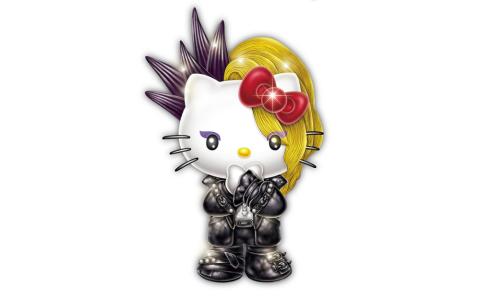
yoshikitty - based on rock star YOSHIKI | ©'24 SANRIO CO.,LTD. ©'24 JMA Co.,Ltd
In recent decades, kawaii has transformed from a specifically Japanese concept into a truly global phenomenon. From Hello Kitty to Harajuku fashion, cartoon mascots to cat cafes, communities around the world have embraced kawaii culture and style. But as revealed in “Yes, KAWAII is Art –EXPRESS YOURSELF–”, the latest exhibition at JAPAN HOUSE Los Angeles, kawaii can have many layers of meaning. The term “kawaii” translates to “cute” or “adorable” in English, but its meaning in Japan goes beyond mere aesthetics to encompass a complex cultural concept with deep roots. How did kawaii develop in Japan, and then go on to inspire so many fans worldwide?
In the Japanese language, kawaii denotes something cute, but also implies something that is delicate, powerless, or requires care. Psychologists suggest this is the essence of “cuteness” as it is perceived across diverse cultures – a reaction in the viewer responding to “baby-like” qualities, and perhaps an evolutionary signal to nurture those creatures that are helpless and vulnerable (ie, actual babies). In 2012, the Osaka University professor Hiroshi Nittono conducted a research study that showed “cuteness” impacts behavior in observers, like increased focus and attention. Professor Nittono concluded that “Kawaii things not only make us happier but also affect our behavior.”

Photo by Suti Stock Photo/Shutterstock.com
In Japan, artists and artisans have shown an appreciation for this quality going back centuries, with some notable examples like Edo-era painters who often depicted puppies and dogs in especially cute ways (read an article to learn more about the love of dogs in Japanese culture), or the craft of extremely small and adorable miniatures, from sword accessories to toy trains (read an article to learn more about the history of miniatures in Japan). But while it has deep historical roots, kawaii evolved in a special way in Japan from the mid-20th century onwards.
Emerging from the devastation of WWII, Japan went through rapid urbanization and massive social change, causing a longing for simplicity, innocence and tradition on the part of the public. As pop culture forms like manga and anime became prominent in the postwar period, they became key vehicles for kawaii characters and aesthetics. Scholars consider the debut of “Astro Boy” (Tetsuwan Atomu), created by Osamu Tezuka in 1952, to be a milestone in the history of kawaii. This iconic character, with his huge eyes, innocent appearance, and heroic adventures, captured the imagination of children and adults alike, and paved the way to more kawaii characters in the spotlight.

yoshikitty dolls from YOSHIKI's personal collection
As Japan’s economy grew in the 1960s and 70s, young people became a major consumer market, with products and services were increasingly tailored to them. Companies like Sanrio, founded in 1960, became a consumer goods giant by targeting young people through cute designs and characters on everything from school supplies to clothing and many other products. As legend has it, Sanrio founder Shintaro Tsuji discovered that by painting a flower on rubber sandals, it sold more pairs than the plain ones, so he devoted his company to adorning products with cute motifs. With their introduction of Hello Kitty in 1974, a new kawaii superstar was born, and became a symbol of Japan abroad, further linking the image of Japan to that of cuteness.
Through the 1980s and 90s, Japanese creations like the Tamagotchi digital pet craze channeled cuteness – revolving around “taking care” of imaginary creatures – and became huge hits overseas. And in the 1990s, the vibrant scene of Japanese street fashion in hubs like Tokyo’s Harajuku neighborhood became known for its particularly “cute” aesthetics, involving pastel colors, childlike motifs, and maximalist accessories. As captured in magazines like Fruits, kawaii street style became an inspiration for countless Western designers and pop stars like Gwen Stefani.

Courtesy of Harajuku Day LA
As the current JAPAN HOUSE Los Angeles exhibition illustrates, kawaii has left its mark on global pop culture, and also the world of big business, making even huge corporations pay attention to the appeal of cuteness. But at its core, the artist and exhibition organizer Sebastian Masuda wants visitors to experience that kawaii cannot be bought and sold – it’s far more than a consumer product or even a trend. In the spirit of young people creating their own DIY street style outfits, kawaii is fundamentally about joy, self-expression, and openness towards others. Kawaii can transcend boundaries of age, race, nationality, class, and ability, connecting individuals to a sense of community and shared vulnerability. In an increasingly challenging world, the “caring” that is the essence of kawaii could hardly be more valuable.

